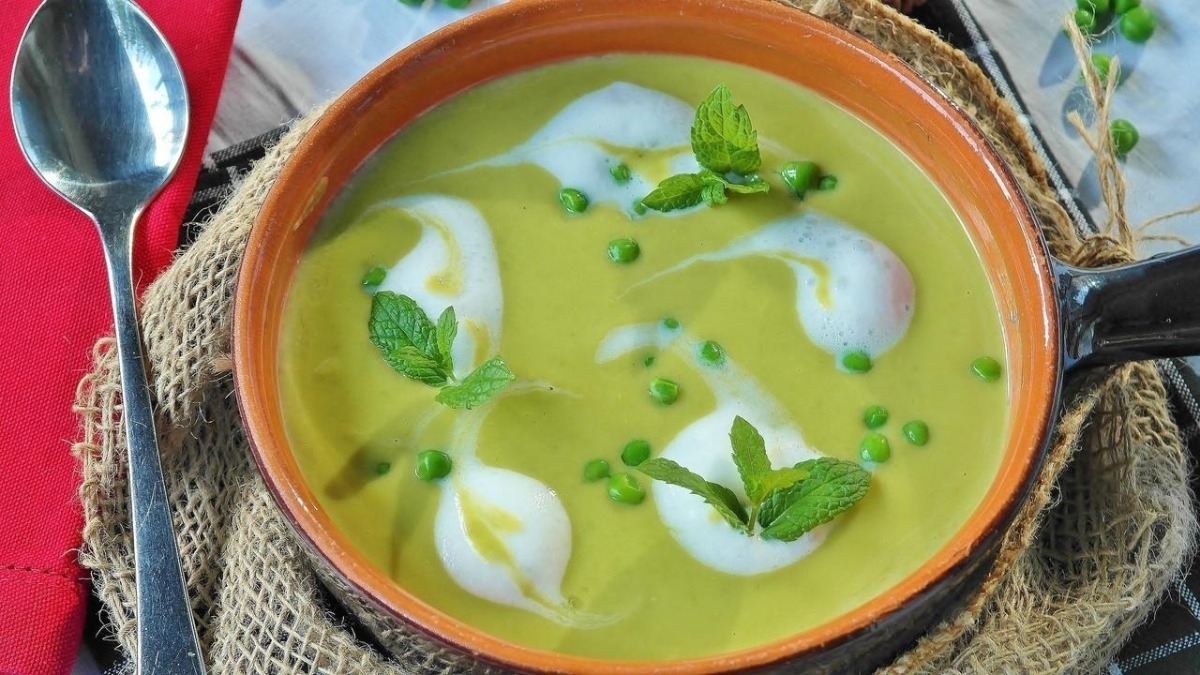Hearty, Healthy, Split Pea Soup with Spices and Herbs. Dairy-free, Vegan, Super Easy to Make!
Whole Food Plant Based Split Pea Soup Recipe
Course: Soup, Snacks, Breakfast
Cuisine: French Recipe, British Recipe
Prep Time: 5 minutes
Cook Time: 30 minutes
Passive Time: 6 hours
Servings: 4 People
INGREDIENTS
1 cup Split Peas / 2 cups Fresh Green Peas
1 Onion
5 cloves Garlic
1 stalk Celery
1 tsp Black Pepper Powder
4 tsp Miso Paste (Healthy Salt Alternative. See Nutrition Science Highlights below)
1 tsp Almond Butter
10 Mint Leaves / Pudina Leaves
Juice of 1 Lemon
INSTRUCTIONS
- Soak split peas overnight or at least for 6 hours. Skip this step if using fresh green peas.
- Peel and chop onion. Peel and crush or grind garlic to a paste and keep separately for ten minutes. Chop celery into slices.
- Cook peas, onion and celery with minimal water or steam until cooked, adding garlic once it has rested for ten minutes. (See Nutrition Science Highlights for details)
- Cool completely, then blend with half of the almond butter, black pepper powder, miso paste, half of the mint leaves, and lemon juice.
- Dilute remaining almond butter with a little water to make almond cream. Garnish split pea soup with almond cream and remaining mint leaves. Warm up if needed. Serve fresh!

Plant Based Chef Pro Tips for Best Split Pea Soup Recipe
- Use other herbs to garnish, such as thyme, parsley, basil leaves, curry leaves, and sage leaves for a wider range of flavours.
- Add spices like cinnamon, star anise, or bay leaves while cooking split peas for a stronger flavor.
Nutrition Science Highlights for WFPB Split Pea Soup Recipe
- Why miso paste? Miso paste is fermented & salted soya bean paste. Maximum recommended salt intake is 3 grams per day per person. In addition to helping us restrict salt intake, replacing salt with miso paste also helps by neutralising the negative effects of salt by soya phytonutrients. You can easily make fresh miso paste at home by mixing 100 grams of cooked soya paste with 10 grams of salt, or 10 tablespoons of cooked soya paste with 1 tablespoon of salt. If making at home, ensure to use immediately, or freeze in batches to use later.
- Why nuts instead of oil? Whole foods are healthier than processed foods. When nuts are pressed and oil is extracted, fiber and phytonutrients are lost, along with many other nutrients. Therefore, whole nuts are much healthier than oils, whether cold-pressed or refined. In addition, they provide the oil content we need to absorb fat-soluble phytonutrients from other whole plant foods! This may be why nuts are used to garnish nearly every traditional Indian dish!
- Why not dairy? Dairy products have been found to be associated with increased risk of chronic diseases, such as diabetes mellitus, hypertension, obesity, asthma, PCOS, and heart disease. We can still enjoy our milk, cream, and butter though - as long as they are made from whole plant foods!
- Why legumes? Legumes are the #1 number food associated with long life in many recent large studies! They also fuel your gut microbiome through their resistant starch content and slow down glucose absorption, keeping your blood sugar levels steady - even in the next meal! This has been called the Second Meal Effect. This recipe is one of the yummiest ways to include pulses and legumes in your daily diet.

